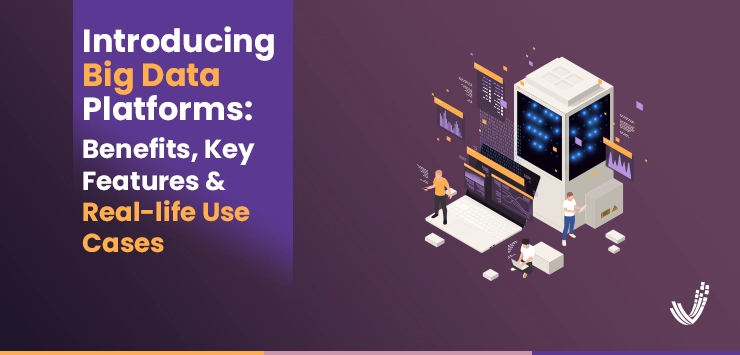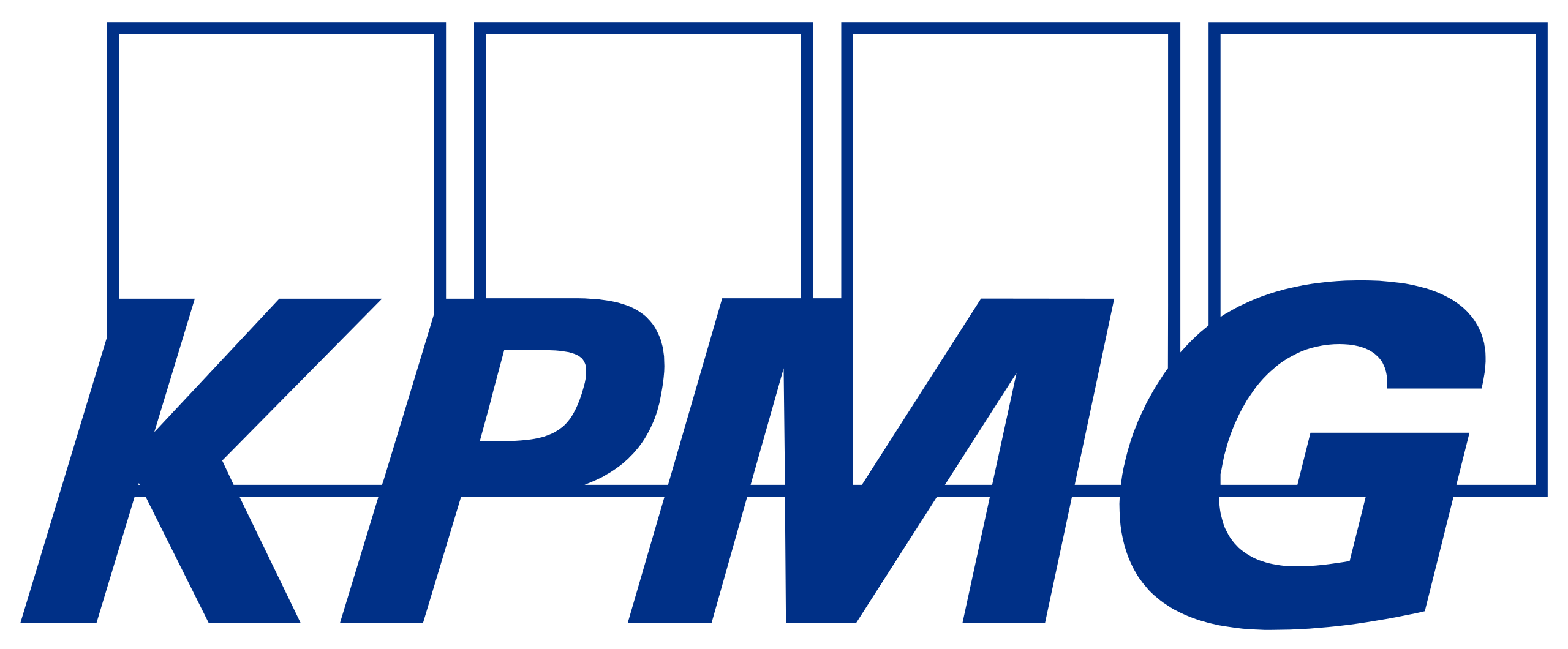The global big data analytics market was valued at over $240 billion in 2021 and is projected to exceed $650 billion by 2029. This is because the massive generation of new data from all sectors including healthcare, retail, public services, manufacturing and more.
The avalanche of data and information comes with both challenges and opportunities. Today, data is being generated at a scary-fast rate, and it is reshaping our world—mostly for good.
But can organizations harness the power of this data to gain valuable insights and make informed decisions? Can they use data to their advantage?
Yes, and that is where big data, and big data platforms come into play.
These platforms provide the infrastructure and tools to process, store, and analyze massive datasets and are used later to extract meaningful information.
They also offer a range of advantages, including faster and scalable data processing, enhanced security, and privacy measures. Big data platforms have it all.
Moreover, with support for features like distributed computing and advanced analytics capabilities, big data platforms enable businesses to uncover valuable insights and drive innovation.
But before that, let’s quickly have a look at the definition of big data and what it really is.
What is Big Data?
The term “big data” refers to information characterized by its immense variety, enormous volumes, and remarkable velocity. Does this sound boring and complex? Let’s make it easy.
When data is in great numbers, so much that it cannot be handled or managed via conventional means, it is normally called big data.
Conventional data management and storage is beyond the scope of data of this size, hence, a lot of cloud data platforms have adopted big data to cater to their needs.
But why is that?
Unlike traditional data, big data presents unique challenges that cannot be effectively managed or processed using conventional tools. The vastness, complexity, and pace at which data is being generated is beyond the limits of traditional data management platforms and tools.
Also, big data usually includes both structured and unstructured data, further contributing to its complexity.
How a Big Data Platform Works
The big data platform workflow is generally divided into several steps. Let’s walk through the process to develop a better understanding.
· Stage 1: Data Collection
In the first stage, it gathers insights from diverse sources like social media, sensors, weblogs, and databases. Big Data platforms effortlessly capture this data for analysis to be done in the later stages.
· Stage 2: Data Storage
In the second stage, a big data platform securely stores valuable data in reliable repositories such as Hadoop Distributed File System, Amazon S3, or Google Cloud Storage. Rest assured; the data is safe and easily accessible.
· Stage 3: Data Processing
The third stage transforms the raw data into valuable insights. It filters, refines, and aggregates the data using powerful distributed processing frameworks like Apache Spark, Apache Flink, or Apache Storm.
· Stage 4: Data Analytics
Stage four focuses on extracting the potential of the processed data. It dives deep into analytics with state-of-the-art tools, including ML algorithms, predictive analytics, and captivating data visualizations with multiple variations.
· Stage 5: Data Governance
The fifth stage ensures the accuracy, completeness, and security of the data being processed using multiple protocols. Data governance practices, such as cataloging, quality management, and lineage tracking, safeguard the data’s integrity.
· Stage 6: Data Management
The sixth and last step enables efficient management of the data ecosystem. Big data platforms provide seamless management capabilities, allowing businesses to make backups, data recovery planning, and archiving it for future use.
What are the Benefits of a Big Data Platform?
While there can be numerous benefits of a big data platform, some of them truly stand out. Here are some of the top benefits of a big data platform.
- A big data platform helps uncover and extract valuable data and information for timely and informed decision-making.
- By using the right platform for their big data requirements, businesses can save significant time and resources for streamlined data processing.
- A dependable big data platform can easily manage large amounts of data while ensuring reliability and efficiency.
- Big data platforms, no matter what the use, are generally agile and can quickly adapt to unique business requirements and needs.
- Big data platforms enable businesses to use data in a manner that helps in personalizing end-user experiences and optimizing their operations for improved efficiency.
- Big data technologies and tools can significantly help reduce the incurred infrastructure cost, improve resource allocation, and strategically align with organizational goals.
- These platforms for big data allow for better innovation and advanced technologies like artificial intelligence and predictive analytics.
- Any big data platform can help avert the risk and proactively identify and mitigate risk through historical data and insights.
- Big data platforms, among many other benefits, allow teams to work better by collaborating and sharing data timely.
Enterprise big data platforms are incredibly beneficial for businesses around the world. With their capability to handle large amounts of data, they enable businesses to always stay competitive and be at par with ongoing market trends.
Where Does Big Data Come From?
Big data originates from two primary sources. It is either user-generated data or machine-generated data.
User-generated data includes emails, images, transactional data, and other forms of information created by individuals.
On the other hand, machine-generated data is produced by various sources such as Internet of Things (IoT) devices and machine learning algorithms.
The availability of big data depends on its owner and their preferences. Some owners make their data commercially accessible to the public in various ways; others don’t.
These platforms enable others to access and utilize the data for a variety of purposes.
However, there are instances where access to certain big data sets may require a subscription or some form of authorization—mainly through APIs.
The diverse nature of big data and its accessibility options present a plethora of opportunities for individuals, organizations, and researchers to leverage these valuable insights for analysis, innovation, and intelligent decision-making.
Interesting fact: In 2020, the market for predictive analytics software using big data reached a substantial value of $5.29 billion. Looking ahead, experts predict an impressive growth trajectory, with the market expected to jump to a whopping $41.52 billion by 2028. This remarkable progress showcases the increasing importance and widespread adoption of big data analytics in various industries.
Examples of Big Data
Big data can be found in various forms and may have a wide range of sources. Here are some examples of the types of data that fall under the ambit of big data:
Mobile Phone Details
The vast amount of information generated through mobile devices, including call records, location data, app usage, and more, contributes to big data.
Social Media Content
The constant stream of posts, updates, photos, videos, stories, and interactions on social media platforms generates enormous volumes of data that form an integral part of big data.
Health Records
The digitization of healthcare has resulted in the accumulation of massive amounts of patient data, including medical records, test results, treatment history, and other health-related information.
Transactional Data
Retail purchases, financial transactions, online orders, and other similar activities generate significant volumes of data that provide valuable insights into consumer behavior and market trends.
Web Searches
The billions of searches performed on search engines every day contribute to the ever-growing pool of big data. This data helps improve search algorithms, personalize user experiences, and track trends.
Weather Information
Weather sensors, satellite data, and meteorological observations generate a wealth of data that helps forecast weather patterns, analyze climate changes, and support disaster management efforts.
What is a Big Data Platform?
Big data platforms are an efficient storage solution for handling vast volumes of data.
These big data platforms leverage a combination of advanced hardware and software tools to collect and manage large datasets, typically utilizing cloud infrastructure.
The primary objective of a big data platform is to organize this immense amount of information in a manner that facilitates the extraction of valuable insights when needed.
Through the employment of multiple data management tools, these platforms ensure that data is stored in a structured and comprehensible format, making it easier to uncover meaningful patterns and trends.
The ability to handle data on a massive scale makes a big data platform able to streamline the process of data collection and storage.
Here’s another simple definition of a big data platform:
“A big data platform is a secure, accessible and organized storage medium for data present in large amounts, and in different places. Big data platforms leverage a mix and match of data management hardware capabilities and modern software tools to save aggregated data sets, and mostly, the storage medium is cloud storage.”
Moreover, a big data platform makes it easy to harnesses cloud technology to provide the necessary infrastructure for efficiently collecting, processing, and storing data, enabling organizations to benefit from its full potential.
Key Features & Characteristics of a Big Data Platform
While there can be multiple features one would want to have on the platform they are employing, a good big data platform must have the below-mentioned features and characteristics.
Quick Deployment
A good big data platform must support quick and hassle-free deployment. It should provide easy installation processes and clear instructions, allowing your business to get up and running swiftly without significant delays or technical complexities.
Data Format Support
A reliable big data platform should possess the ability to handle a wide range of data formats; whether it’s structured data like spreadsheets and databases, unstructured data like social media posts or sensor data, or even multimedia data like images and videos, the platform should be equipped to process and analyze diverse data types efficiently.
Data Transformation
An essential feature of a capable big data platform is its capacity to transform data into different preferred formats. This includes converting data from one format to another, such as changing data from a CSV file to JSON or collecting and summarizing data to create meaningful insights for analysis, reporting, or otherwise.
Big Data Handling
A robust big data platform should be able to handle substantial volumes of data, including streaming in real-time and massive databases. It should have the necessary infrastructure and computing power to efficiently store, manage, and analyze big data, ensuring scalability and optimal performance.
Speed
The speed at which a big data platform can collect, store, and process data is crucial. Whichever of the big data platforms you choose, it should be capable of handling data with speed, whether it’s rapid real-time streaming data or high-speed batch processing.
Data Scouring
An effective big data platform should provide powerful tools for scouring and analyzing data from massive datasets. These tools should allow you to search and visualize data, enabling them to identify patterns, correlations, and trends hidden within the vast sea of information. The platform should also support advanced querying for in-depth analysis and discovery of valuable insights.
Adaptability
A flexible big data platform should be adaptable to evolving business needs. It should have the capability to integrate new applications and tools seamlessly and must be compliant and supportive of the incorporation of emerging technologies. This enables businesses to leverage the latest advancements and stay ahead in the race to properly interpret the data.
Scaling
Scalability is a critical feature of a dependable big data platform. Big data platforms should grow along with the increasing demands of the business, accommodating larger datasets and increasing requirements.
The platform’s scalable infrastructure and architecture should ensure uninterrupted performance and efficient resource utilization as data volumes and processing increase.
Real-life Use Cases of a Big Data Platform
There are many real-world use cases of a big data platform. Let’s have a look at a few of them.

Situation
T-Mobile faced a challenge of building a nationwide 5G network while ensuring effective and accurate reporting on data and metrics related to supply chain and business critical information. The existing landscape of disparate data sources and systems made it difficult and time-consuming to ensure real-time metrics, leading to the need for a solution to centralize data to optimize planning and reporting that would be effective and efficient.
Solution
The solution was to create a data lakehouse solution with Azure Synapse to centralize all their data and make it significantly more accessible and flexible across the organization. Power BI was then used to create stunning dashboards to support the usage and understanding of procurement and supply chain data and encourage more data-driven decision making during the 5G initiative.
Impact
The data lakehouse created with Microsoft Azure Data Factory, Azure Synapse Analytics, and Azure Databricks, enabled T-Mobile to centralize data and improve security, eliminating workload contention and ensuring data isolation. The data lakehouse also facilitated the creation of stunning dashboards, using Microsoft Power BI, to support the understanding of procurement and supply chain data and encourage more data-driven decision making. T-Mobile was able to successfully execute the building of a nationwide 5G network, which required a massive ramp-up in cell tower site construction and ensure that sites were built on time.

Situation
KPMG was looking to empower application developers to rapidly build their own cloud infrastructure while maintaining the firm’s security posture. The existing legacy lab environment offered great flexibility and speed for testing cloud services, but there were trade-offs concerning secure tenant-level policies, flexible access controls, and data classification restrictions. There was also a need to support training, proof of concepts, and application demos to internal clients that included cloud services that have not been vetted by KPMG security.
Solution
To mitigate this issue, a pre-development Azure landing zone was introduced with self-auditable security guardrails which allow developers elevated privileges to safely experiment with cloud services and build their applications in the cloud using KPMG proprietary data.
Impact
The introduction of a pre-development Azure landing zone with self-auditable security guardrails allowed developers elevated privileges to safely experiment with cloud services and build their applications in the cloud using KPMG proprietary data. The solution also enables data scientists to fine-tune their AI & ML models with rapid prototyping, increased agility, and reduced time to market. The KPMG app dev teams adopted the pre-dev Azure landing zone to migrate to the cloud in just eight days, reducing time to market by 50-60%.

Situation
AMD IT, as a leader in semiconductor technology, was facing an ever-increasing need for more computing resources for its product development and verification processes. The team was looking for scalability, reliability, and adaptability for its hybrid environments to preserve capacity and reliability. The solution implemented has enabled AMD to reduce delays and accelerate time to market.
Solution
By using Azure resources, AMD IT was able to speed up job times and reduce time to market by scaling up virtual machines (VMs) configured for high-performance computing (HPC) to meet bursts of demand and then scale back down when the machines aren’t needed.
Impact
The solution also helped AMD IT shorten ramp-up times, gain flexibility, and speed up job times, which ultimately sped up design cycle times and reduced time to market. Additionally, AMD IT was able to strategically plan for which machines and processes it would need at any given time, allowing them to positively impact the company’s bottom line.

Situation
Mondelēz International had an aging on-premises infrastructure that needed to be replaced to enable new business and product innovations. The company was also facing increasingly severe security threats and needed to ramp up its security posture. In addition, the company wanted to move as many of its systems as possible to the cloud to gain scalability, flexibility, and agility.
Solution
The solution that Mondelez adopted was to move most of its IT assets, including much of its business-critical SAP landscape, to Microsoft Azure. By doing so, Mondelēz International improved SAP application performance by up to 50 percent, halved its disaster recovery time and boosted availability of key systems.
Impact
The decision to move to Azure allowed the company to introduce additional layers of security, including Azure Active Directory, in a flexible and agile way, which was not possible in a static, on-premises environment. Additionally, the company was able to reduce costs and upgrade its infrastructure while meeting the rapidly evolving digital requirements of its consumers. The company’s digital capability is now integral to its strategy and everything it does to further accelerate profitable growth.
Top 7 Big Data Platforms You Should Know
There are multiple big data platforms being used today, but a few of them top the list for various reasons. Let’s learn about the best big data platforms so that it’s easy for you to choose them and get the ideal results.
1. Google Cloud
Google Cloud offers specialized big data tools like BigQuery, Dataflow, and Data Studio for efficient data management and custom visualization.
2. Microsoft Azure
Azure supports Apache technologies like Hadoop and Spark for data analysis, along with native tools like HDInsight for streamlined data cluster analysis.
3. Amazon Web Services
AWS provides analytics tools for data preparation, warehousing, SQL queries, and data lake design, scaling resources securely with growing data.
4. Snowflake
Snowflake is a data warehouse running on public cloud infrastructures (AWS, Google Cloud, MS Azure) with a SQL query engine for storage, processing, and analysis.
5. Cloudera
Built on Apache Hadoop, Cloudera handles massive data volumes, including machine logs, with its Data Warehouse and DataFlow for real-time data analysis.
6. Tableau
Tableau enables users to discover correlations, trends, and interdependencies in data sets, enhanced by the Data Management add-on for granular cataloging.
7. Talend
Talend’s Stitch allows quick data loading into warehouses, while Data Fabric combines integration, governance, integrity, application, and API integration. The above-listed big data platforms are the top ones being used by businesses worldwide. Each of these platforms has unique features and serves varying requirements.
Other Notable Big Data Platforms
Apart from the ones enlisted earlier in this blog, here are some more big data platforms that you must know about.
Sumo Logic
Sumo Logic troubleshoots, tracks business analytics, and detects security breaches using cloud-native machine learning capabilities.
Sisense
Sisense offers a fast data analytics platform with in-chip technology, customizable dashboards, AI-powered insights, and future business opportunity identification.
Collibra
Collibra aids data-heavy industries by providing semantic search, contextual result unraveling, and quality data discovery company-wide.
Qualtrics Experience Management
Qualtrics analyzes customer, employee, product, design, and brand experiences to predict insights using AI and machine learning.
Teradata
Vantage analytics software works with public cloud services and Teradata Cloud storage, optimizing machine learning and NewSQL engine capabilities.
Oracle
Oracle Cloud’s big data platform automatically migrates diverse data formats to the cloud, operates on-premise, and offers a free tier option.
Domo
Domo’s platform integrates and simplifies big data from multiple sources, offering industry-specific findings, AI-based predictions, and easy integration.
MongoDB
MongoDB stores data as flexible JSON documents offers real-time search functionality, and is designed for app developers.
Civis Analytics
Civis Analytics provides end-to-end data services, from ingestion to modeling and reporting, with secure collaboration capabilities.
Alteryx
Alteryx simplifies data workflows and predictive analytics with interdepartmental collaboration, R and Python code deployment, and quick insights.
Zeta Global’s Marketing Platform
Zeta Global optimizes omnichannel marketing efforts using its vast permission-based database and AI-driven targeting.
Vertica
Vertica’s SQL data warehouse analyzes data from various storage spaces, offering predictive analytics and columnar storage for speed and efficiency.
Treasure Data
Treasure Data’s customer data platform creates individualized customer profiles for personalized marketing.
Actian Avalanche
Actian’s cloud-native data warehouse delivers near-instantaneous results with multi-query support and ready-made connections to popular apps.
Greenplum
Greenplum uses PostgreSQL to handle varied data analysis and operations projects, with built-in extensions for location-based analysis and more.
Hitachi Vantara’s Pentaho
Pentaho streamlines data ingestion through drag-and-drop integration offers data-agnostic analysis, and mines business intelligence from any format.
Exasol
Exasol’s in-memory analytics database works with all types of data, facilitates massively parallel processing, and offers cloud and appliance deployment options.
IBM Cloud
IBM Cloud’s platform provides customizable big data management with various databases, in-memory analysis, and integration of open-source tools.
MarkLogic
MarkLogic’s flexible database handles diverse data types and metadata, integrates with analytics apps and offers an easy drag-and-drop import process.
Datameer
Datameer simplifies data integration and analysis with a wizard-based upload, point-and-click cleansing, and a library of functions for non-technical users.
Alibaba Cloud
Alibaba Cloud offers a variety of database formats and big data tools, including data warehousing, streaming analytics, and high-speed Elasticsearch.
Apache Storm
Apache Storm is a distributed real-time computation system that processes streams of data with high scalability and fault tolerance.
Databricks
Databricks provides a unified analytics platform built on Apache Spark, enabling efficient data processing, machine learning, and collaborative data science workflows.
Frequently Asked Questions
A very good example of a big data platform is Apache Hadoop.
It is an open-source framework that allows for the distributed processing of large data sets across clusters of computers using simple programming models.
Hadoop is designed to scale up from a single server to thousands of machines, each offering local computation and storage. Its core components include the Hadoop Distributed File System (HDFS) for storage and MapReduce for processing.
Other examples include Apache Spark, which provides fast in-memory processing, and Google BigQuery, a cloud-based big data analytics platform.
A big data platform is designed to collect, store, process, and analyze massive volumes of data. It performs several key functions:
- Data Ingestion: It gathers data from various sources, including databases, IoT devices, social media, and logs.
- Data Storage: It stores data in a scalable and distributed manner, often using technologies like HDFS or cloud storage solutions.
- Data Processing: It processes data using batch or real-time processing frameworks or big data platforms like Apache Hadoop, Spark, or Flink.
- Data Analysis: It provides tools for analyzing data to uncover patterns, trends, and insights. This often includes machine learning and statistical analysis capabilities.
- Data Management: It includes features for data governance, metadata management, and data quality to ensure that data is accurate, consistent, and compliant with regulations.
Big data refers to extremely large and complex data sets that traditional data processing applications, frameworks or methods are inadequate to handle.
It is characterized by the three Vs: Volume (large amounts of data), Velocity (fast data generation and processing), and Variety (diverse types of data).
A data platform, or a big data platform, on the other hand, is the technology infrastructure designed to manage and process data.
This includes big data but also encompasses other types of data management systems. A data platform typically includes databases, data warehouses, data lakes, and big data tools.
While big data focuses on the data itself, a data platform provides the tools and technologies needed to handle that data effectively.
Various sectors benefit significantly from big data, including:
Healthcare: Big data helps in predictive analytics, personalized medicine, patient monitoring, and operational efficiency.
Finance: Financial institutions use big data for fraud detection, risk management, personalized banking, and investment analysis.
Retail: Retailers leverage big data for inventory management, customer insights, personalized marketing, and sales forecasting.
Manufacturing: Manufacturers use big data for predictive maintenance, quality control, supply chain optimization, and operational efficiency.
Logistics: Logistics companies benefit from big data in route optimization, demand forecasting, supply chain management, and fleet management.
Telecommunications: Telecom companies use big data for network optimization, customer experience improvement, and churn prediction.
Big data enables these sectors to make data-driven decisions, enhance operational efficiencies, improve customer experiences, and gain a competitive advantage.
Big data risk refers to the potential challenges and threats associated with managing and using large data sets.
These risks include:
Data Breaches: Unauthorized access to sensitive data can lead to significant financial and reputational damage.
Privacy Concerns: Handling personal data increases the risk of violating privacy laws and regulations, such as GDPR or CCPA.
Data Quality Issues: Inaccurate, incomplete, or inconsistent data can lead to faulty analysis and poor decision-making.
Compliance and Regulatory Risks: Ensuring compliance with various data protection regulations is complex and can lead to legal penalties if not properly managed.
Security Threats: Large data sets are attractive targets for cyber-attacks, requiring robust security measures.
Storage and Management Costs: Storing and processing large volumes of data can be expensive and require significant resources.
Integration Challenges: Integrating big data with existing systems and processes can be complex and time-consuming.
Effective data governance, robust security protocols, and comprehensive risk management strategies are essential to mitigate these risks and ensure that big data initiatives are successful and secure.
Conclusion – Is There No Future of Big Data Platforms?
Big data platforms are here to stay!
Businesses today are actively seeking avenues to leverage big data in order to gain valuable insights and make smarter decisions, as well as to manage tons of data being generated every day.
To meet this fast-growing demand, big data platforms have emerged as comprehensive solutions that address all data requirements in one place.
These platforms facilitate the collection, organization, storage, retrieval, sharing, evaluation, and reporting of data insights, making them an extensive tool to do what needs to be done.
Big data platforms allow businesses to have the flexibility to select the format of data they prefer to work with and choose the right platform accordingly.
For this, if you require any assistance, our dedicated technical experts are available to support you every step of the way. Visit Veraqor contact us page for more.















